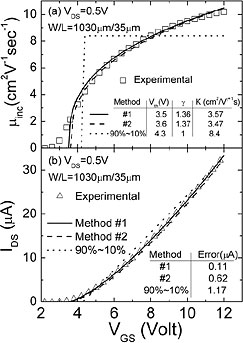
Research Archives Index
Improved Field-Effect Mobility Model for Amorphous In-Ga-Zn-O Thin-Film Transistors
Tze-Ching Fung and Jerzy Kanicki
 The conventional approach to extract the electrical parameters from thin-film transistors (TFTs) IDS/VGS data is to apply the standard MOSFET drain current equation which assumes constant field-effect mobility (μeff). The μeff and threshold voltage (Vth) can be extracted from a simple linear fit of the on-region drain current data and this method is frequently used in most of the ionic metal oxide semiconductor TFT studies. However, when analyzing the IDS/VGS data for a-IGZO TFTs, we observed a deviation between the actual data and the theoretical prediction based on standard MOSFET equation. Inconsistent results might be obtained if the proper data range (VGS range) is not specified. The conventional approach to extract the electrical parameters from thin-film transistors (TFTs) IDS/VGS data is to apply the standard MOSFET drain current equation which assumes constant field-effect mobility (μeff). The μeff and threshold voltage (Vth) can be extracted from a simple linear fit of the on-region drain current data and this method is frequently used in most of the ionic metal oxide semiconductor TFT studies. However, when analyzing the IDS/VGS data for a-IGZO TFTs, we observed a deviation between the actual data and the theoretical prediction based on standard MOSFET equation. Inconsistent results might be obtained if the proper data range (VGS range) is not specified.
Further analysis of the linear region transfer data reveals a non-linear IDS/VGS behavior observed in a-IGZO TFT at the higher VGS: the IDS seems to be higher than expected for a given VGS. In other words, the apparent field effect mobility is dependent on VGS and the μeff extracted from standard MOSFET equation can only be considered as an average value. We propose an improved TFT IDS/VGS model for accurate device parameter extraction. A new drain current equation is derived by introducing a gate voltage dependent field-effect mobility (μeff(VGS)) into the standard MOSFET equation. The a-IGZO TFT parameters were extracted based on the improved model. Two independent extraction routines were exercised. The first method determines the parameters by finding the minimum fitting error over a trial threshold voltage range, while the second method extract all parameters by a more straight-forward, two steps processes. Two methods give very similar results which demonstrate the consistency of the new approach. In addition, as compared to the tradition method, the improved model can reach a reduced fitting error with 10 times improvement. This project is supported by DARPA.
T.-C. Fung, K. Nomura, H. Hosono and J. Kanicki, Digest of Technical Papers, SID, 2008 Vehicles and Photons, pp. 117-123, 2008.
top
|

